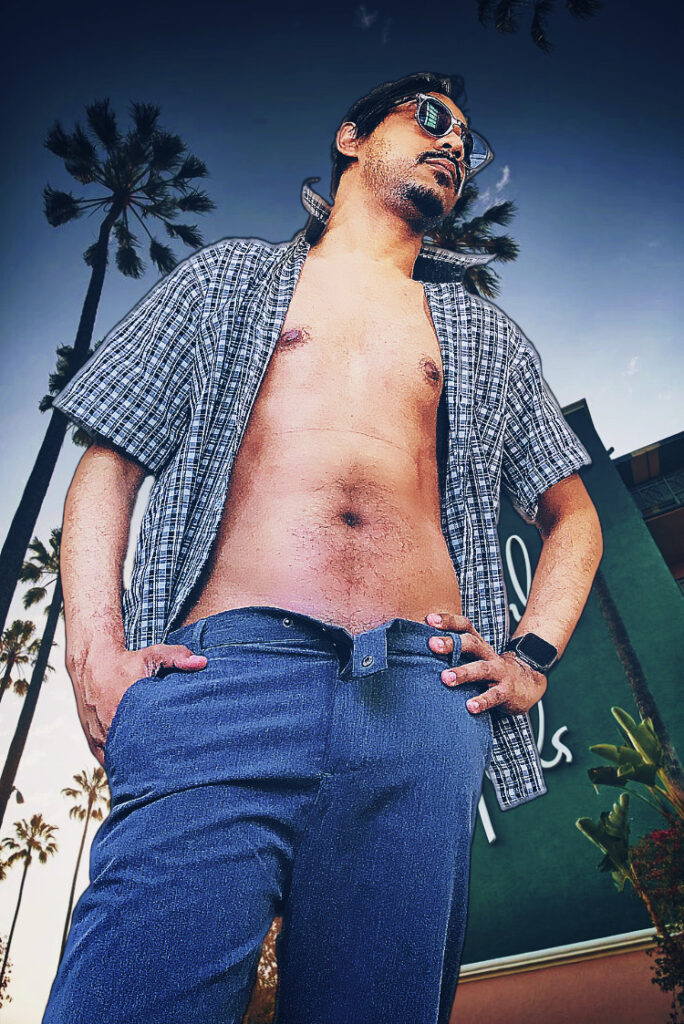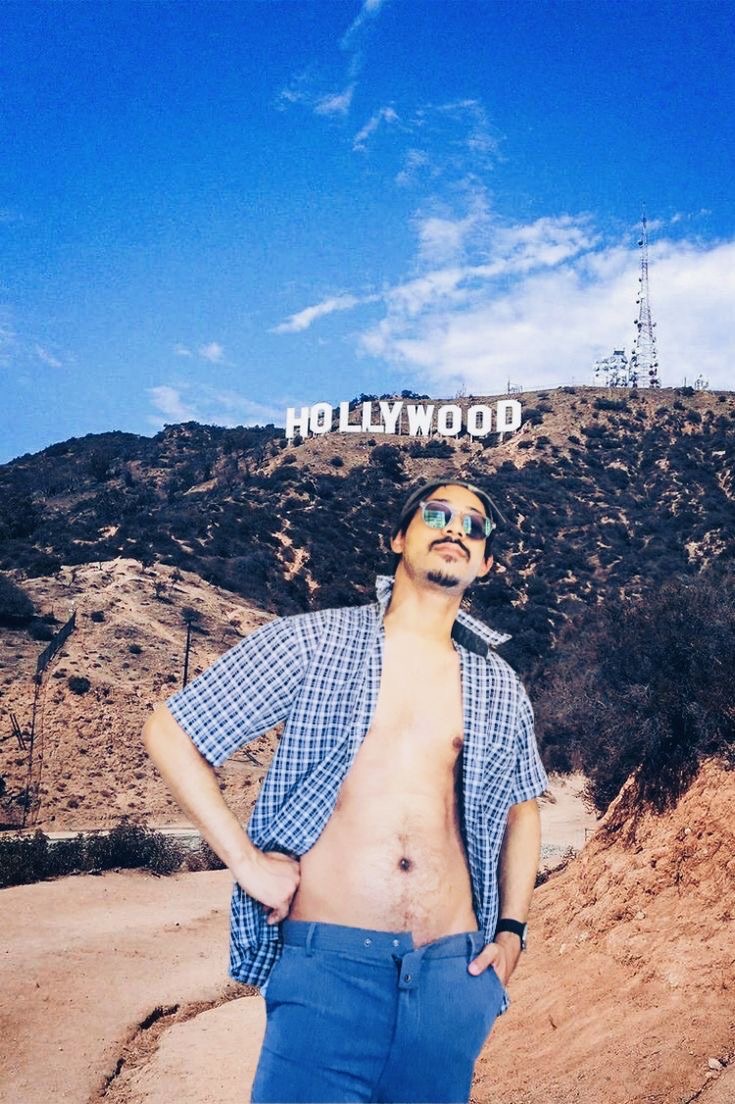Hollywood has everything to do with Saulo Oliveira. Don’t even get the British-Brazilian model started on Golden Age movies. The singer-songwriter is very familiar with almost everything, from the movies to local specific behind-the-scenes gossip in Los Angeles from 1930 to 1960. That’s because, as a musician devoted to telling stories with his music, being an old soul artist comes as something that does serve him well. Saulo is, for instance, an observer and when it comes to Hollywood classics, like a trivia master, the answers are all on the tip of his tongue.
The Vents magazine “sexiest rocker alive” is what you would call an OG (an original) in the ever-evolving world of Rock music. Since childhood, he enjoyed creating short stories and singing Oasis and The Beatles. This, his knowledge about specific subjects proves that there’s more than the eyes can see.
When it comes to movies Saulo is always aware of the purpose of the characters in each scene, and specific dialogues, and it’s all narrated and wrapped in expressions such as “deus ex machina”, “mise-en-scene” and “contre-plongée”. Just a few phrases delivered and you’ll get convinced that he knows what he is talking about. His passion for arts, in general, is contagious. And yet there’s that feeling that only those with the privilege of being in his presence can describe precisely. It is the dichotomy of a person containing the appeal of classical scholarship and at the same time being beautifully fresh and current, he has the appeal of the past whilst being a glimpse of the future. Saulo looks like the star boy that Slim Aarons never photographed but could and should have. If you take a sip of your water and get distracted and look away while he talks when your eyes return to that clean, youthful face, you are reminded again of the amazement of all that knowledge coming from someone with a fragrance-commercial-face model, so young and so cool that the last thing you would imagine about him would be that he’s an all-things-savant.





Owner of a catalogue of songs distinguished by palindromes, alliterations, subliminal messages in sentences sung in reverse, overlapping voice, fancy words describing daily-base matters, poignant scenes, short stories with complex innuendos and, of course, devilish harmonica solos, Saulo lives up to the intricacy of his signature music work, after all, with all those ingredients combined, he is founding a new Rock and Roll scholasticism. It is no exaggeration to say that there is ALT Rock before and after Saulo.
Churning out a plethora of definitive gems that continue to captivate audiences such as the conceptual EP “Prince of Rock”, for example, which in four songs traverses the psyche of the character Mack Mcneil, it is easy to understand how cinema classics and the mystical atmosphere of Los Angeles can have such a strong influence on Oliveira’s artistic vision. “In my draft versions, Mack wandered around famous L.A. landmarks while filming some of his short films (on film, not digital), while also working as a bricklayer in Compton and having a garage band. I had to shorten this hero’s rise to fame because Renewing Rock N Roll is already too long as it is, let alone the original version. Anyway, it was an interesting experience to conceive this character, to study more about the industry and an opportunity to learn more about the history of Beverly Hills, the promised land where Mack ends up taking up residence after rising as a music titan.”.
But it’s not just his characters who have stories with a cinematic narrative. Saulo’s own past and his first steps towards some notoriety have the outline of a Hollywood script.
On June 6, 2006, while playing his harmonica at the crossroads, waiting for the school bus with some friends, Saulo saw a strange man approaching. All elegant in a black suit and with a pale face, the man introduced himself as the devil and challenged the boy to a solo harmonica duel. The stranger assured him that his instrument, the Elder Harmonica, had a peculiar and powerful energy. If Saulo won the duel, he could keep the instrument, but if the boy lost, he would have to give the man his soul. Saulo’s friends looked at each other and began to laugh uncontrollably. The man began to play.
As soon as the man’s harmonica solo ended, there was no longer a trace that those faces had ever had a smile on them once. The affliction was general. Apparently, in hell, people are busy having harmonica lessons 24/7, in other words, the strange-devil was an excellent soloist. But Saulo was not intimidated. By playing Ennio Morricone’s “Man With a Harmonica”, Oliveira managed not only to keep his soul intact, but as a reward, he also saw the man bow down and hand him the Elder Harmonica, kneeling even. So, just hours after the hero’s classmates spread the story on Orkut, the community “The boy who defeated the devil and became bigger than God” skyrocketed into a phenomenon, with thousands of adepts. Exactly, “adepts” and not “followers”, because what started was a true fanatic cult with some reminiscent activity yet nowadays.
On Saulo’s debut album “Wild Horizon”, it was finally possible to hear the Elder Harmonica, after years of the composer being reluctant about using the instrument, in 2020. Before that, in 2013, Oliveira directed a short film about a protest scene in the “June Journeys” for which he also composed the soundtrack. “Ethics, Politics and Citizenship” has a camera style typical of the language of someone like Oliveira, a connoisseur of the seventh art. Therefore, from his earliest years, whether in the legendary (script-worthy) starting point from the roots of the internet or in the projects undertaken, the atmosphere of Hollywood has somehow surrounded him.
“One of the greatest triumphs of Once Upon a Time in the West is the soundtrack. The film would not be the same without that masterful OST orchestrated by Morricone. Harmonica’s solos should never lose their charm. They should be more present in films that call for a tense scene because it has an immediate effect on the viewer. The last major example of this was Robbie Robertson with Scorsese’s Irishman theme, after which I haven’t seen many different instruments being explored in film compositions. It’s always good to break the homogeneity of standard soundtracks and in this sense, more creative composers need to be encouraged. Synthesizers became popular after Stranger Things, as did the 80s aesthetic in general, and, as trends come and go, maybe it’s time for the harmonica. But I’m biased when it comes to this matter”, says the rockstar.
Now, on the verge of five years after releasing his first album, the Prince of Rock is sure that it’s time to come back. A full album is in post-production and, despite his emblematic disappearances, Saulo says he’ll try to show up more consistently until the release of new songs, but at the same time, he doesn’t guarantee anything.
“I said I’ll try. Want me to show up? Stick a picture of me on the bathroom wall, turn off the light, light up a black candle, call my name in front of the mirror and flush the toilet six hundred and sixty-six times. I might get up from my coffin and show up to give an interview to some magazine, but you’d have to follow these steps,” laughs the singer, at the height of his British humour.
Overall, whether in front of the Beverly Hills Hotel, in the hotel’s pool or with the Hollywood sign in the background, Los Angeles seems to blend into Oliveira’s image naturally, in any hues and textures. The backdrop that serves as the theme for the next album? In the Wizard of Words’s words, “It’s needless to say any more words”.

